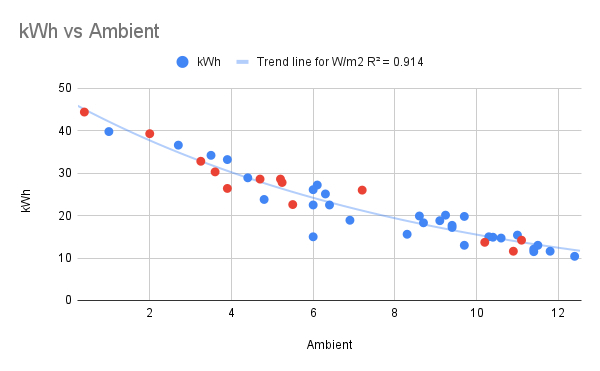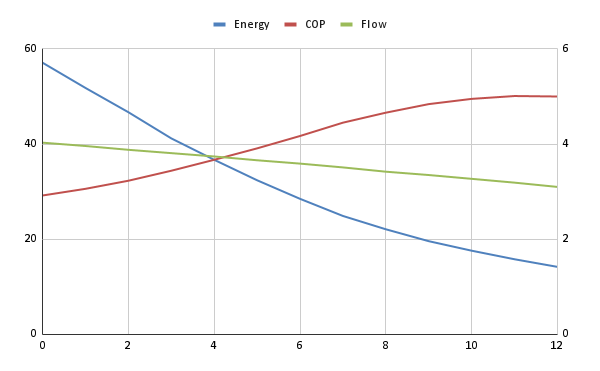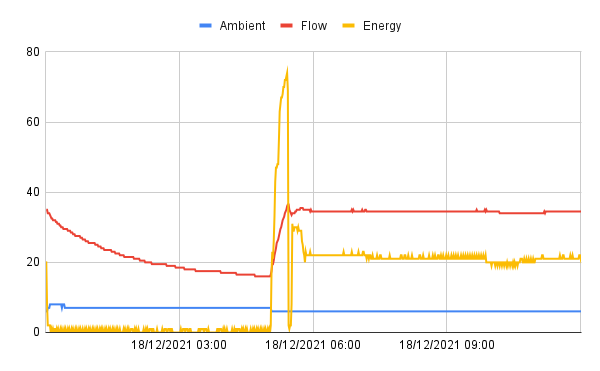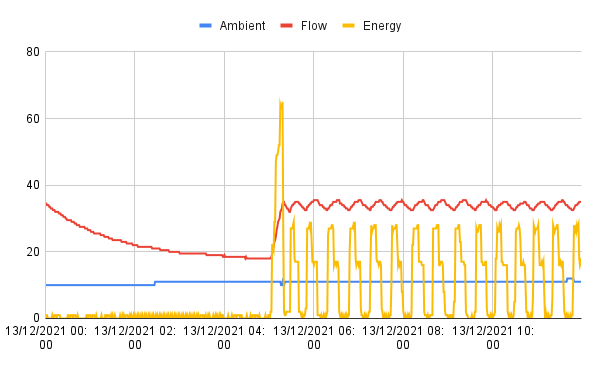We’d like to remind Forumites to please avoid political debate on the Forum.
This is to keep it a safe and useful space for MoneySaving discussions. Threads that are – or become – political in nature may be removed in line with the Forum’s rules. Thank you for your understanding.
The MSE Forum Team would like to wish you all a Merry Christmas. However, we know this time of year can be difficult for some. If you're struggling during the festive period, here's a list of organisations that might be able to help
📨 Have you signed up to the Forum's new Email Digest yet? Get a selection of trending threads sent straight to your inbox daily, weekly or monthly!
Has MSE helped you to save or reclaim money this year? Share your 2025 MoneySaving success stories!
I bought a Heat Pump
Comments
-
That seems very sensible @Meatballs . Can it be generalised?
8.5/2.5 = 3.4
So whatever CoP is achieved running "hard" for 2.5 hours; the CoP needs to be over 3.4 times better (when maintaining a constant temperature for 8.5 hours) in order to save money. I think that must be correct.Reed0 -
Very unlikely indeed. At its nominal compressor speed, my ASHP, at 2C ambient, has a COP of 2.9 when producing flow at 40C and 2.4 at 55C. That's including an allowance for defrosts. Most other modern ASHPs have similar performance.Meatballs said:
8.5 hours (maybe less if the HP is actually cycling off for periods) at your efficient COP kWhReed_Richards said:I use a nighttime set-back on my heating controller. For the sake of simplicity we'll say it is 21 C from 07:00 to 22:30 then 18 C overnight. If the outside temperature is near 0 C it takes about 6 hours for the temperature to cool from 21 to 18 so the heat pump is off all that time. That leaves 2.5 hour for my controller to get the temperature back up to 21 C in time for 07:00. It will do this automatically if I set "Comfort Mode". But to do this it has to make the water in my radiators hotter than is necessary to maintain a constant 21 C which means it will be running less efficiently.
Which is better for fuel economy, @shinytop's strategy of maintaining a constant internal temperature or mine? With a conventional boiler I should win but with a heat pump it's not so obvious. I'll have to try to read my heat pump meter after 22:30 and then (if I wake up in time) at 07:00 the following day to find out how much electricity that 2.5 hours of hard work uses.
vs
2.5 hours at your inefficient COP kWh
Almost certainly the 2.5 hours?
If it's a 10kWh heater running at COP1 for 2.5 hours = 25kWh
If it's running at COP 3 for 8.5 Hours - 3.333*8.5 = 28.33kWh
Unlikely you will be down to COP1?1 -
I think the fact that it looks like a straight line and I've plotted one is misleading. Remember this is power consumption; you wouldn't really expect this to be a straight line between 1 and 11C because the ASHP is less efficient when it's colder. The power produced should be a straight line relationship. But for a boiler, produced = consumed X efficiency, where efficiency is constant no matter what the temperature. I think ...Reed_Richards said:The truth is what I actually do is more complicated than my simple explanation. I set back the room temperature by 3 C at 22:30 then up by 1 C in time for 07:00 and gradually up during the day until it arrives back at the base temperature (21 C) at 17:00. I've been doing something like that for the past 24 years, ever since I had a programmable room thermostat and with whatever boiler. It's what feels comfortable; I think because as the day progresses we get more sedentary and need it a bit warmer. So in terms of heat demand that's probably very similar to @shinytop 's red dot data.
That's a very interesting chart, @shinytop ; I'm still getting my head around the trend line. I suppose with a conventional boiler the power requirement would double from 11 C to 1 C ambient (because 2*(21-11) = 21-1 ) whereas with your heat pump arrangement it's nearer treble rather than double.
EDIT - exponential?
3 -
Well yes and no. I accept that one probably should not expect a linear relationship and hence a straight line. But over your range of ambient temperatures it's not too far off a straight line meaning there is a reasonable approximation to a linear relationship.shinytop said:
I think the fact that it looks like a straight line and I've plotted one is misleading.Reed1 -
That was the actuals, this is the model. It uses my heat loss calcs and the published performance figures for my ASHP. The numbers assume constant ambient temperature with the house at 21C, for 24 hrs. I know that's not quite what happens in practice but the numbers are close to what I get. The flow is effectively my weather compensation curve. LH axis is energy, RH is COP and X is ambient.Reed_Richards said:
Well yes and no. I accept that one probably should not expect a linear relationship and hence a straight line. But over your range of ambient temperatures it's not too far off a straight line meaning there is a reasonable approximation to a linear relationship.shinytop said:
I think the fact that it looks like a straight line and I've plotted one is misleading.
0 -
That's very interesting, @shinytop. Is the model something you constructed yourself?
Your flow temperatures are much lower than mine, by about 10 C. My MCS certified figure is 50 C and my weather compensation only kicks-in above 4 C.Reed0 -
Someone on another forum did it. It's set up around the published Ecodan figures but you could easily use it for other models ifReed_Richards said:That's very interesting, @shinytop. Is the model something you constructed yourself?
Your flow temperatures are much lower than mine, by about 10 C. My MCS certified figure is 50 C and my weather compensation only kicks-in above 4 C.
you had the data.
https://renewableheatinghub.co.uk/forums/renewable-heating-air-source-heap-pumps-ashps/dereks-heat-pump-modeling-tool#post-3793
In a way I'm lucky because my whole system/rads is designed to work at lower temps. In another way I'm not because I had to pay for it all.
But even it I changed from 40C to 50C flow, COP changes from 2.8 to about 2.4 at 0C so not that bad. The other point not covered is that these numbers are steady state. The COP will drop a lot when the ASHP is working very hard, which happens when you let external thermostats switch it on and off and it has to heat the water up from cold repeatedly.0 -
My system, asked to maintain a constant temperature when it's less than 4 C outside will heat the flow water up to 50 C. Shortly afterwards the compressor switches off. This must usually be because the return water gets too hot because it happens most of the time. The water cools to the low 30s and the cycle repeats. The average flow temperature is probably fairly constant but the hysteresis is very large. Is maintaining a constant average flow temperature with a high degree of hysteresis more consumptive of energy than with very little hysteresis? The answer is not intuitively obvious to me.shinytop said:
The COP will drop a lot when the ASHP is working very hard, which happens when you let external thermostats switch it on and off and it has to heat the water up from cold repeatedly.
Edit: Well given that the compressor is off for a minute or two every 15 minutes it must be working a bit harder. But is the any more to it than that?Reed0 -
I think there is. I don't think it's going to be as efficient with a very high hysteresis. It depends how your ASHP works but I think it's the case with mine. Both graphs are midnight to 12 noon. The first graph is when it's <6C

The ASHP is off at night so the flow temp drops to about room temp. It kicks in at 5am and goes at high power to reach desired flow temp. It then settles down to a steady pace and keeps the flow temp very constant. On the LH scale, 20 = c. 1.2kW. I'm happy enough to pay for 1.2kW but wouldn't want to be paying for 4-5kW very much; once in the morning is offset by the zero consumption all night.
The second graph is from when it was warmer. Same time period, different day.
The initial blip is lower and shorter as expected. You can see it then trying to run steadily but it can't modulate down enough so cycles on and off. The flow temp only varies 2-3C. The average consumption during the cycling is about 0.7kW.
I don't really know the answer to your question but it would seem that raising the flow temp a lot uses a lot of power.
Are you sure your flow temp is dropping so much because the return temp is too high or is it because a thermostat stops calling for heat? It's the latter situation that I'm now avoiding.0 -
For me, and perhaps for anyone else considering an ASHP, the moral of this technical discussion with @shinytop is that ASHP heating controls are not very sophisticated. In particular they tend to lack a feature called 'Load Compensation' so they don't know how hard they should work to maintain a constant room temperature. Because of this they don't modulate to achieve the output flow temperature necessary to maintain the room temperature. I live with this, whilst @shinytop works around it by just using Weather Compensation to maintain a constant room temperature (24/7) without using a room thermostat.
By contrast, gas boilers generally can do Load Compensation (with the right controller) in fact I bought one in 1998 that had this feature.Reed2
Confirm your email address to Create Threads and Reply

Categories
- All Categories
- 352.9K Banking & Borrowing
- 253.9K Reduce Debt & Boost Income
- 454.7K Spending & Discounts
- 246K Work, Benefits & Business
- 602.1K Mortgages, Homes & Bills
- 177.8K Life & Family
- 259.9K Travel & Transport
- 1.5M Hobbies & Leisure
- 16K Discuss & Feedback
- 37.7K Read-Only Boards



